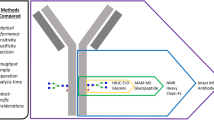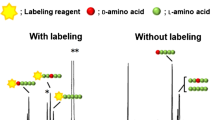Abstract
Metal ions serve important roles in structural biology applications from long-range perturbations seen in magnetic resonance experiments to electron-dense signatures in X-ray crystallography data; however, the metal ion must be secured in a molecular framework to achieve the maximum benefit. Polypeptide-based lanthanide-binding tags (LBTs) represent one option that can be directly encoded within a recombinant protein expression construct. However, LBTs often exhibit significant mobility relative to the target molecule. Here we report the characterization of improved LBTs sequences for insertion into a protein loop. These LBTs were inserted to connect two parallel alpha helices of an immunoglobulin G (IgG)-binding Z domain platform. Variants A and B bound Tb3+ with high affinity (0.70 and 0.13 μM, respectively) and displayed restricted LBT motion. Compared to the parent construct, the metal-bound A experienced a 2.5-fold reduction in tag motion as measured by magnetic field-induced residual dipolar couplings and was further studied in a 72.2 kDa complex with the human IgG1 fragment crystallizable (IgG1 Fc) glycoprotein. The appearance of both pseudo-contact shifts (−0.221 to 0.081 ppm) and residual dipolar couplings (−7.6 to 14.3 Hz) of IgG1 Fc resonances in the IgG1 Fc:(variant A:Tb3+)2 complex indicated structural restriction of the LBT with respect to the Fc. These studies highlight the applicability of improved LBT sequences with reduced mobility to probe the structure of macromolecular systems.







Similar content being viewed by others
References
Barb AW, Ho TG, Flanagan-Steet H, Prestegard JH (2012) Lanthanide binding and IgG affinity construct: potential applications in solution NMR, MRI, and luminescence microscopy. Protein Sci 21:1456–1466. doi:10.1002/pro.2133
Barbato G, Ikura M, Kay LE, Pastor RW, Bax A (1992) Backbone dynamics of calmodulin studied by 15 N relaxation using inverse detected two-dimensional NMR spectroscopy: the central helix is flexible. Biochemistry 31:5269–5278
Barthelmes K et al (2011) Engineering encodable lanthanide-binding tags into loop regions of proteins. J Am Chem Soc 133:808–819. doi:10.1021/ja104983t
Bertini I, Luchinat C, Parigi G (2002) Paramagnetic constraints: an aid for quick solution structure determination of paramagnetic metalloproteins. Concepts Magn Reson 14:259–286. doi:10.1002/Cmr.10027
Butler A (1998) Vanadium haloperoxidases. Curr Opin Chem Biol 2:279–285
Cavanagh J (2007) Protein NMR spectroscopy: principles and practice, 2nd edn. Academic Press, Boston, Amsterdam
Cornilescu G, Marquardt JL, Ottiger M, Bax A (1998) Validation of protein structure from anisotropic carbonyl chemical shifts in a dilute liquid crystalline phase. J Am Chem Soc 120:6836–6837
Deisenhofer J (1981) Crystallographic refinement and atomic models of a human Fc fragment and its complex with fragment B of protein A from Staphylococcus aureus at 2.9- and 2.8-A resolution. Biochemistry 20:2361–2370
Delaglio F, Grzesiek S, Vuister GW, Zhu G, Pfeifer J, Bax A (1995) NMRPipe: a multidimensional spectral processing system based on UNIX pipes. J Biomol NMR 6:277–293
DeLano WL, Ultsch MH, de Vos AM, Wells JA (2000) Convergent solutions to binding at a protein-protein interface. Science 287:1279–1283
Feeney J, Birdsall B, Bradbury AF, Biekofsky RR, Bayley PM (2001) Calmodulin tagging provides a general method of using lanthanide induced magnetic field orientation to observe residual dipolar couplings in proteins in solution. J Biomol NMR 21:41–48. doi:10.1023/A:1011924017938
Gaponenko V, Dvoretsky A, Walsby C, Hoffman BM, Rosevear PR (2000) Calculation of z-coordinates and orientational restraints using a metal binding tag. Biochemistry 39:15217–15224
Hanson QM, Barb AW (2015) A perspective on the structure and receptor binding properties of immunoglobulin G Fc. Biochemistry 54:2931–2942. doi:10.1021/acs.biochem.5b00299
Hiruma Y et al (2013) The structure of the cytochrome p450cam-putidaredoxin complex determined by paramagnetic NMR spectroscopy and crystallography. J Mol Biol 425:4353–4365. doi:10.1016/j.jmb.2013.07.006
Huang F, Pei Y-Y, Zuo H-H, Chen J-L, Yang Y, Su X-C (2013) Bioconjugation of proteins with a paramagnetic NMR and fluorescent tag. Chem Eur J 19:17141–17149. doi:10.1002/chem.201302273
Iwahara J, Clore GM (2006) Detecting transient intermediates in macromolecular binding by paramagnetic NMR. Nature 440:1227–1230. doi:10.1038/nature04673
Iwahara J, Schwieters CD, Clore GM (2004a) Characterization of nonspecific protein-DNA interactions by 1H paramagnetic relaxation enhancement. J Am Chem Soc 126:12800–12808. doi:10.1021/ja046246b
Iwahara J, Schwieters CD, Clore GM (2004b) Ensemble approach for NMR structure refinement against (1)H paramagnetic relaxation enhancement data arising from a flexible paramagnetic group attached to a macromolecule. J Am Chem Soc 126:5879–5896. doi:10.1021/ja031580d
Johnson BA, Blevins RA (1994) NMR view: a computer-program for the visualization and analysis of NMR data. J Biomol NMR 4:603–614
Keniry MA, Park AY, Owen EA, Hamdan SM, Pintacuda G, Otting G, Dixon NE (2006) Structure of the theta subunit of Escherichia coli DNA polymerase III in complex with the epsilon subunit. J Bacteriol 188:4464–4473. doi:10.1128/JB.01992-05
Koehler J, Meiler J (2011) Expanding the utility of NMR restraints with paramagnetic compounds: background and practical aspects. Prog Nucl Magn Reson Spectrosc 59:360–389. doi:10.1016/j.pnmrs.2011.05.001
Lee MD et al (2015) Compact, hydrophilic, lanthanide-binding tags for paramagnetic NMR spectroscopy. Chem Sci 6:2614–2624. doi:10.1039/c4sc03892d
Liu Y, Prestegard JH (2009) Measurement of one and two bond N–C couplings in large proteins by TROSY-based J-modulation experiments. J Magn Reson 200:109–118. doi:10.1016/j.jmr.2009.06.010
Loh CT, Ozawa K, Tuck KL, Barlow N, Huber T, Otting G, Graham B (2013) Lanthanide tags for site-specific ligation to an unnatural amino acid and generation of pseudocontact shifts in proteins. Bioconj Chem 24:260–268. doi:10.1021/bc300631z
Loh C-T, Graham B, Abdelkader EH, Tuck KL, Otting G (2015) Generation of pseudocontact shifts in proteins with lanthanides using small “Clickable” nitrilotriacetic acid and iminodiacetic acid tags. Chem Eur J 21:5084–5092. doi:10.1002/chem.201406274
Markley JL et al (1998) Recommendations for the presentation of NMR structures of proteins and nucleic acids–IUPAC-IUBMB-IUPAB Inter-Union task group on the standardization of data bases of protein and nucleic acid structures determined by NMR spectroscopy. Eur J Biochem 256:1–15
Martin LJ, Imperiali B (2015) The best and the brightest: exploiting tryptophansensitized Tb3 + luminescence to engineer lanthanide-binding tags. In: Derda R (ed) Peptide libraries: methods and protocols, vol 1248. Methods in molecular biology. pp 201–220. doi:10.1007/978-1-4939-2020-4_14
Matsumiya S et al (2007) Structural comparison of fucosylated and nonfucosylated Fc fragments of human immunoglobulin G1. J Mol Biol 368:767–779. doi:10.1016/j.jmb.2007.02.034
Nilsson B et al (1987) A synthetic IgG-binding domain based on staphylococcal protein A. Protein Eng 1:107–113
Nitz M, Franz KJ, Maglathlin RL, Imperiali B (2003) A powerful combinatorial screen to identify high-affinity terbium(III)-binding peptides. ChemBioChem 4:272–276. doi:10.1002/cbic.200390047
Otting G (2008) Prospects for lanthanides in structural biology by NMR. J Biomol NMR 42:1–9. doi:10.1007/s10858-008-9256-0
Parekh RB et al (1985) Association of rheumatoid arthritis and primary osteoarthritis with changes in the glycosylation pattern of total serum IgG. Nature 316:452–457
Park SH, Wang VS, Radoicic J, De Angelis AA, Berkamp S, Opella SJ (2015) Paramagnetic relaxation enhancement of membrane proteins by incorporation of the metal-chelating unnatural amino acid 2-amino-3-(8-hydroxyquinolin-3-yl)propanoic acid (HQA). J Biomol NMR 61:185–196. doi:10.1007/s10858-014-9884-5
Pilla KB, Leman JK, Otting G, Huber T (2015) Capturing conformational states in proteins using sparse paramagnetic NMR data. PLoS ONE. doi:10.1371/journal.pone.0127053
Prestegard JH, Bougault CM, Kishore AI (2004) Residual dipolar couplings in structure determination of biomolecules. Chem Rev 104:3519–3540. doi:10.1021/Cr030419i
Saio T, Ogura K, Yokochi M, Kobashigawa Y, Inagaki F (2009) Two-point anchoring of a lanthanide-binding peptide to a target protein enhances the paramagnetic anisotropic effect. J Biomol NMR 44:157–166. doi:10.1007/s10858-009-9325-z
Schmitz C, Stanton-Cook MJ, Su XC, Otting G, Huber T (2008) Numbat: an interactive software tool for fitting Delta chi-tensors to molecular coordinates using pseudocontact shifts. J Biomol NMR 41:179–189. doi:10.1007/s10858-008-9249-z
Shulman RG, Wuthrich K, Yamane T, Antonini E, Brunori M (1969) Nuclear magnetic resonances of reconstituted myoglobins. Proc Natl Acad Sci USA 63:623–628
Silvaggi NR, Martin LJ, Schwalbe H, Imperiali B, Allen KN (2007) Double-lanthanide-binding tags for macromolecular crystallographic structure determination. J Am Chem Soc 129:7114–7120. doi:10.1021/ja070481n
Sjodt M et al (2015) The PRE-derived NMR model of the 38.8-kDa tri-domain IsdH protein from staphylococcus aureus suggests that it adaptively recognizes human hemoglobin. J Mol Biol. doi:10.1016/j.jmb.2015.02.008
Skinner SP, Liu W-M, Hiruma Y, Timmer M, Blok A, Hass MAS, Ubbink M (2015) Delicate conformational balance of the redox enzyme cytochrome P450cam. Proc Natl Acad Sci USA 112:9022–9027. doi:10.1073/pnas.1502351112
Starovasnik MA, Braisted AC, Wells JA (1997) Structural mimicry of a native protein by a minimized binding domain. Proc Natl Acad Sci USA 94:10080–10085
Su XC, Huber T, Dixon NE, Otting G (2006) Site-specific labelling of proteins with a rigid lanthanide-binding tag. ChemBioChem 7:1599–1604. doi:10.1002/cbic.200600142
Su XC, McAndrew K, Huber T, Otting G (2008) Lanthanide-binding peptides for NMR measurements of residual dipolar couplings and paramagnetic effects from multiple angles. J Am Chem Soc 130:1681–1687. doi:10.1021/ja076564l
Subedi GP, Barb AW (2015) The structural role of antibody N-glycosylation in receptor interactions. Structure 23:1573–1583. doi:10.1016/j.str.2015.06.015
Subedi GP, Moniz HA, Johnson RW, Moremen KW, Barb AW (2015) High yield expression of recombinant human proteins with the transient transfection of HEK293 cells in suspension JoVE (in press)
Tashiro M, Tejero R, Zimmerman DE, Celda B, Nilsson B, Montelione GT (1997) High-resolution solution NMR structure of the Z domain of staphylococcal protein A. J Mol Biol 272:573–590. doi:10.1006/jmbi.1997.1265
Tolman JR, Flanagan JM, Kennedy MA, Prestegard JH (1995) Nuclear magnetic dipole interactions in field-oriented proteins: information for structure determination in solution. Proc Natl Acad Sci USA 92:9279–9283
Wei Z, Yang Y, Li Q-F, Huang F, Zuo H-H, Su X-C (2013) Noncovalent tagging proteins with paramagnetic lanthanide complexes for protein study. Chem Eur J 19:5758–5764. doi:10.1002/chem.201204152
Yagi H, Pilla KB, Maleckis A, Graham B, Huber T, Otting G (2013) Three-dimensional protein fold determination from backbone amide pseudocontact shifts generated by lanthanide tags at multiple sites. Structure 21:883–890. doi:10.1016/j.str.2013.04.001
Yang Y, Wang J-T, Pei Y-Y, Su X-C (2015) Site-specific tagging proteins via a rigid, stable and short thiolether tether for paramagnetic spectroscopic analysis. Chem Commun 51:2824–2827. doi:10.1039/c4cc08493d
Zheng D, Aramini JM, Montelione GT (2004) Validation of helical tilt angles in the solution NMR structure of the Z domain of Staphylococcal protein A by combined analysis of residual dipolar coupling and NOE data. Protein Sci 13:549–554. doi:10.1110/ps.03351704
Zweckstetter M, Bax A (2000) Prediction of sterically induced alignment in a dilute liquid crystalline phase: aid to protein structure determination by NMR. J Am Chem Soc 122:3791–3792. doi:10.1021/Ja0000908
Acknowledgments
We thank Prof. James H. Prestegard (CCRC, UGA) for helpful suggestions throughout this project and use of the 21.1 T and 14.1 T spectrometers, Dr. D. Bruce Fulton (ISU) for help with NMR experiments, Prof. Vincenzo Venditti (ISU) for a critical reading of the manuscript and the Roy J. Carver Charitable Trust (Muscatine, IA) for supporting scientific instrumentation. This work was financially supported by the grant R01-GM115489 from the National Institutes of Health and the Roy J. Carver Department of Biochemistry, Biophysics & Molecular Biology at Iowa State University. The content of this work is solely the responsibility of the authors and does not necessarily represent the official views of the NIH or ISU.
Author information
Authors and Affiliations
Corresponding author
Rights and permissions
About this article
Cite this article
Barb, A.W., Subedi, G.P. An encodable lanthanide binding tag with reduced size and flexibility for measuring residual dipolar couplings and pseudocontact shifts in large proteins. J Biomol NMR 64, 75–85 (2016). https://doi.org/10.1007/s10858-015-0009-6
Received:
Accepted:
Published:
Issue Date:
DOI: https://doi.org/10.1007/s10858-015-0009-6




